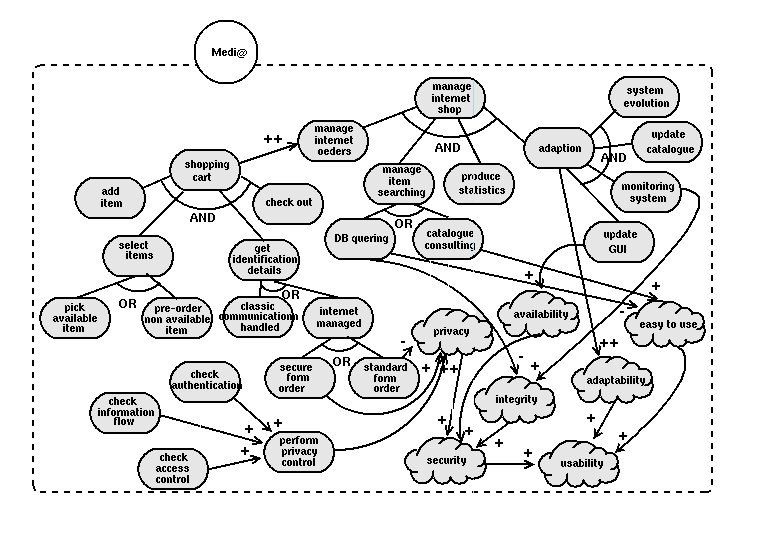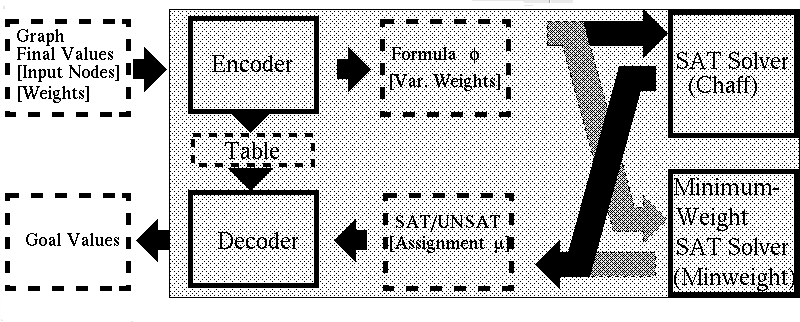
Tropos is an agent-oriented software development methodology founded on two
novel features. First, the methodology is defined in terms of the concepts of agent,
goal, and related mentalistic notions. These notions are used to support all software
development phases, from early requirements analysis to implementation. Second, a
crucial role is given to early requirements analysis that precedes prescriptive requirements
specification for the system-to-be. As such, Tropos supports earlier phases of
software development compared to other agent- and object-oriented methodologies.
Software development begins by identifying relevant stakeholders (represented as actors) and their
goals. These root goals are analyzed, refined, and delegated to existing on new actors.
The system-to-be and its components come about as new actors who are responsible for
the fulfillment of some of the original or refined goals. The whole process ends when
sufficient goals have been delegated so that if all actors fulfill their responsibilities, all
root goals are fulfilled.
Goal analysis process is made concrete by using a formal goal model model.
This goal model supports both qualitative and quantitative relationships between goals,
and can be used to perform two types of analysis.
The first type (forward reasoning) answers questions of the form:
Given a goal model, and assuming that certain leaf goals are fulfilled,
are all root goals fulfilled as well?
The second type of analysis (backward reasoning) solves problems of the form:
Given a goal model, find a set of leaf goals that together fulfill all root goals.
Forward reasoning. Given a goal graph and an initial values assignment to some goals, input goals from
now on (typically leaf goals), forward reasoning focuses on the forward propagation
of these initial values to all other goals of the graph according to the rules described
in Section 3. Initial values represent the evidence available about the satisfaction and
the denial of a specific goal, namely evidence about the state of the goal. Usually such
a evidence corresponds to qualitative values of satisfaction or denial of a goal. This
is mainly because the evidence is usually provided very vaguely by the stakeholders,
during the interviews with the analyst, or elaborated from documents or other available
sources of information.
For each goal we consider three values representing the current evidence of satisfi-
ability and deniability of goal: F (full), P (partial), N (none).We admit also conflicting
situations in which we have both evidence for satisfaction and denial of a goal. So for
instance, we may have that for goal G we have fully (F) evidence for the satisfaction
and at the same time partial (P) evidence for denial. This could represent a situation
in which we have two difference sources of information that provide conflicting evidence,
or a multiple decompositions of goal G, where some decompositions suggest
satisfaction of G while others suggest denial.
After the forward propagation of the initial values, the user can look the final values
of the goals of interest, target goals from now on (typically root goals), and reveal
possible conflicts. In other words, the user observes the effects of the initial values over
the goals of interests.
Backward reasoning.
Backword reasoning focuses on the backward search of the possible input values leading
to some desired final value, under desired constraints. We set the desired final values
of the target goals, and we want to find possible initial assignments to the input goals
which would cause the desired final values of the target goals by forward propagation.
We may also add some desired constraints, and decide to avoid strong/medium/weak
conflicts.
 |
| Figure 1 |
 |
| Figure 2 |
Paolo Giorgini - University of Trento, Italy
John Mylopoulos - University of Toronto, Canada
Roberto Sebastiani - University of Trento, Italy
Alberto Siena - University of Trento, Italy
R. Sebastiani, P.Giorgini, and J. Mylopoulos. Simple and Minimum-Cost Satisfiabilityfor Goal Models. In Proceedings of the 16th Conference On AdvancedInformation Systems Engineering (CAiSE*04), LNCS Springer, 2004.
P. Giorgini, E. Nicchiarelli, J. Mylopoulous, R. Sebastiani. FormalReasoning Techniques for Goal Models. Journal of Data Semantics.Springer, LNCS 2800 - Journal Subline, 2004.
P. Giorgini, J. Mylopoulos, E. Nicchiarelli and R. Sebastiani.Reasoningwith Goal Models. Proceedings ofthe 21st International Conference on conceptual Modeling (ER2002),Tampere, Finland, October 2002. LNCS - Springer Verlag.
Some screenshots of the tool can be found here
Tested operating systems: Windows XP, Linux, MacOS X.
Java Runtime Environment (j2sdk1.4.1_02) or above
In order to perform the quantitative top-down analysis, you also need to have Lingo, v. 8.0 or above, installed in your system
GR-Tool package is no longer available for download, as it has been superseded by CGM-Tool; please follow the link to download a copy.
Once the jvm is correctly installed, you just need to unpack the downloaded file into a directory.
To run it, double-click the GoalEditor.jar file, or type at the shell:
java -jar GoalEditor.jar
Note: if you want to launch the solvers under unix or mac,
the solver directory must be fully readable and writable,
and te solvers must also be executable:
chmod -R ugo+rwx solver
Please submit any bug report to CGM-Tool support staff.
Note for Unix, Linux and MacOS X:
The solvers directory must be rwx for the user.
Quantitative top-down analysis only works under Windows